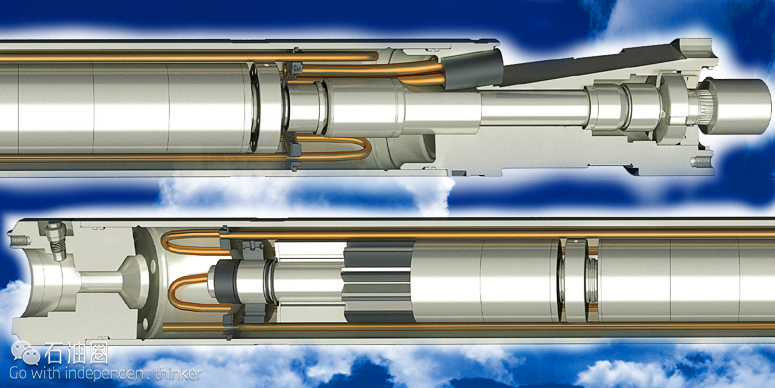The Borets Permanent Magnet Motor (PMM) is designed for the same ESP systems as induction motors, and also for PCPs. However, the PMM shows better performance in harsh environments, such as viscous fluids, high solids content, unstable inflow, low production, post hydro-fracturing or any other artificial lift methods applied.
Moreover, it facilitates the operating procedure for well commissioning.
Under certain operating conditions, a sucker-rod pumping system can be replaced with an ESP system or PCP system featuring a permanent magnet motor.
Unlike a conventional induction motor, the PMM design incorporates a rotor with permanent magnets that are made of sintered hard-magnetic materials. The magnets produce the rotor flux that requires less power for field generation.
As a result the PMM has a higher power density and is shorter than a conventional induction motor of the same horsepower rating. The increased efficiency and the synchronous operation also translate into reduced electrical losses, lower operating current and less heat generation. With less heat generated the motor cooling requirements are reduced and it is possible to operate the system with PMM at lower flow rates than with conventional induction motors. Adaptive surface control allows the system to respond to changing well conditions and extend system run life by optimizing or eliminating cycling in low flow conditions, thus ensuring the maximum production rate. As a result, less heat and faster and more accurate control of the motor allows for an expanded operating range.
The system incorporates a single-section and up to 228-horsepower PMM which can be deployed through smaller 5.5-inch casing. The 4.06-inch PMM is 40% shorter and lighter than conventional induction ESP motors, thereby improving its ability to run in highly deviated sections. The one-piece design reduces installation time and complexity and improves power savings on average by 15%.
Says Keith Russell, VP of Marketing, Borets. “This latest addition to our PMM line eliminates the need for tandem motors for certain applications and provides improved production potential by preventing temperature spikes during startup, ensuring extended equipment run life and increasing our customers’ overall cost savings.”
PMM-pcp System
PMM-PCP systems offer improved operational performance and efficiency in crooked, deviated, horizontal wellbores
Borets Company, the leader in electric submersible pumping (ESP) systems with over 60 years artificial lift expertise, has been designing, manufacturing and servicing PMM driven submersible progressive cavity pumping (PCP) systems for more than 10 years. In this time Borets has installed over 1,500 systems worldwide.
PMM-PCP systems offer the improved operational performance and efficiency vs. other alternatives in wells with crooked wellbores, highly deviated sections or when operation is required in the horizontal. The system allows all the benefits of Progressing Cavity Pumps (PCP) without the safety and abrasion risks associated with a steel rod string to surface. The system is ideal for PCP systems where it is desirable to minimize the surface footprint of the well for environmental impact reasons.
The system has a proven ability to reduce the number of costly workovers associated with rod or tubing wear. Specific examples save 3- 5 pulls in a system life span saving customers thousands of well costs. Imagine operating PCP’s with no rod or tubing pulls.
The PMM-PCP opens up the range in which PCP can be applied. This allows operators to take advantage of the efficiency and solids handling ability of the PCP in wells where this technology was not an option due to well bore geometry. In these challenging conditions PMM-PCP can be the artificial lift of choice to improve economics in project that prove to be difficult to produce economically.
OPERATING ENVELOPE
- Flow rate: 30 – 1,279 BPD (4-180 m3/d)
- Max. head: 8,203 ft (2,500 m)
- Max. operating temperature: 266 0F
- Max. viscosity: 1,000 CP
PMM-PCP SYSTEM COMPONENTS
- Progressive Cavity Pump
- Motor Seal
- Permanent Magnet Motor
- Downhole sensor
- Cable
- Variable Frequency Drive
APPLICATIONS
- Heavy oil
- Deviated, horizontal or crooked wells
- High viscosity wells
- Low flowrate wells
- Highly abrasive fluids
- High scale and asphaltene wells
Submersible PCP systems are considered where traditional rod driven systems are limited by depth or where deviated or crooked wells have caused premature rod/tubing wear as submersible PCP systems have no rods.
However, the conventional Electrical Submersible PCP systems known commonly as an ESPCP comprises a conventional ESP Induction Motor coupled to a gear reducer, allowing the PCP to operate between 100-500 RPM.
The Borets PMM-PCP system has a very similar configuration to that of the ESPCP, the major difference is there is no gear box in the system.
With the introduction of a 10 pole, Permanent Magnet Motor, which has specifically been designed to operate at PCP pump speeds between 350-750 RPM, it allows a submersible PCP system to operate with no need for a gear box. The overall length of the system is reduced. Furthermore, the PMM has a higher electrical efficiency when compared to that of a conventional ESP induction motor.
Permanent Magnet Motors utilize powerful rare earth magnets embedded in the rotor, this allows the rotor to rotate at the same speed as the magnetic field produced by the stator making it a synchronous motor and eliminating slip. Permanent Magnet Motors have a much higher power density allowing the motor to be shorter than a comparable IM The PMM’s also have the ability to output higher starting torque that of a comparable induction motor.
This has greatly improved both the reliability of the system and the economics of challenging wellbores.


 石油圈
石油圈
